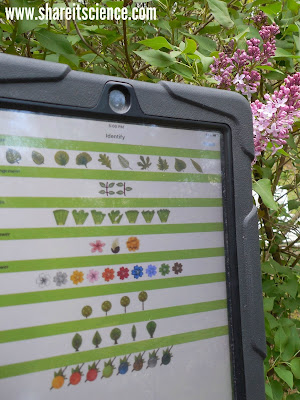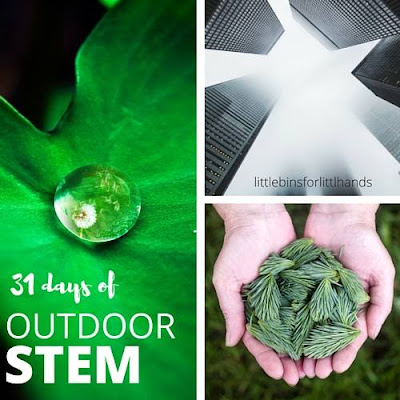A fun outdoor STEAM (Science, Technology, Engineering, Art, Math) activity for kids is yard mapping. Identifying plants and drawing a map of your yard, the park or a nature trail can be a great way to stimulate that growing brain this summer.
This post contains affiliate links, see disclosures for more information.
When kids need a reference guide, I'm
generally the "let's look it up in a book" old-fashioned
type of person. But, technology is at our fingertips and can be super
useful if used properly. One area where using an actual field guide
can be particularly difficult for kids is plant identification.
Although using a dichotomous key is an excellent
science skill to learn, there are tons of botany terms that are not
kid-friendly to wade through in many field guides. If a task is so
frustrating that they lose interest in even trying, then you've lost
the curiosity that stemmed the activity!
Using an app for plant identification
can be faster and more fun. I'd even argue that in some cases, it can
help with accuracy. Here are some free plant i.d. apps that can help
kids identify plants and create their own yard map.
Identify Your Plants!
I've used these free apps on the iPad,
but please note some of them are also available for iPhone and android.
This app was by far the most useful one I found. It worked well with
all plants I tried, from houseplants, landscaped plants and native
plants. Sometimes trees and shrubs from a nursery can be difficult to
identify with a field guide, so this one is particularly good for
that. Snap a picture, then scroll through the archived images
until you find a match, usually it will be the first or second choice. It's designed to work best with flowers, but
I found it to be fairly accurate with leaf pictures as well. For an
extra, nominal, charge you can ask an expert if you really get
stumped.
This app is set up in a very user
friendly way. You pick the attributes of your tree: leaf shape and
orientation, flower color, shape, etc. Then you can choose from
different options to narrow down your tree. The drawback of the free
version is that it only features a few trees. Currently, you can
upgrade to a wider variety of trees for .99 cents.
This is the closest to a field guide
that you will get in terms of vocabulary. There are some scientific
terms kids might not know, but there are also images to help them move
through the key. The free version features the 100 most common trees
in North America.
I've had mixed results with Leafsnap.
You take a picture of a leaf on a white background and then navigate
through some results to find a match. The design of this app is
really nice, however, having to snap your picture on a white
background either means you need to pick a leaf and lay it down
somewhere flat, or play a balancing act while you snap the picture.
Not the best for small hands!
You might also want to try these apps
available for android phones.
This is another one where you snap a
picture and scroll through some suggestions. It is designed to
recognize plants in Europe, however, if you are living somewhere else
you might still find your plant, or match it to the correct plant family. Then it's
just a matter of pulling out the trusty field guide and checking out
a family group rather than trying to identify from scratch.
Although this app isn't meant
specifically for identifying plants, it works well if you can't find
your plant elsewhere. Snap a picture and then Google searches for
similar images. When you find a similar one, you will most likely
also find the plant's name. You'll definitely want to follow up to be
sure that the name you find on Google is accurate with a field guide
or by visiting a reputable plant website.
There are so many different plants, that it is a must to use multiple sources. You'll also want to double-check with a field guide, or online to be sure you've nailed your identification.
Time to Make Your Map!
Once the tech is loaded up, you can
fill up a backpack with the supplies you need to map the yard and get
to work! Here are some things you might want to take with you:
- Device to run the plant identification apps
- Ruler
- Pencil
- Notebook (If your kiddo gets really serious about keeping a nature notebook, you might want to invest in one from Rite in the Rain- they are sturdy and have waterproof paper!)
- Scotch tape
- Clipboard
- Colored pencils
- Kid-friendly field guide, such as Fandex Field Guide: Trees, Fandex Field Guide: Wildflowers, Peterson First Guide to Trees, Peterson First Guide to Wildflowers
- Adding scale to the map
- Adding color to the map
- Observing, identifying and recording what insects, birds and other animals visit specific plants
- Participate in Cornell's citizen science project YardMap and create a digital yard map online
If you are looking for some other great
outdoor STEM and STEAM activities, check out the rest of the posts in
this series, 31 Days of Outdoor STEM, hosted by Little Bins for Little Hands.
Like what you're reading? Don't miss
another Share it! Science News post! Subscribe by e-mail. Just new
posts- no spam! We pinkie swear!









No comments:
Post a Comment